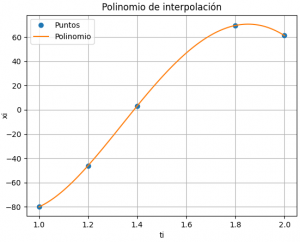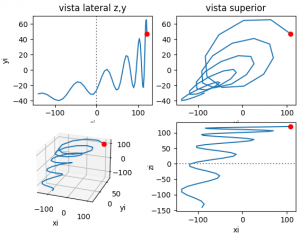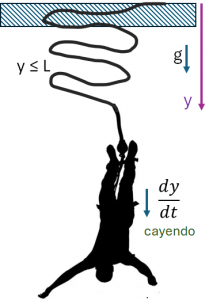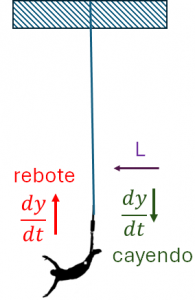Ejercicio: s1Eva_2024PAOII_T3 matriz de distribución de energía por sectores
:
| Fuente\Consumidor | Industrial | Comercial | Transporte | Residencial |
| Hidroeléctrica | 0.7 | 0.19 | 0.1 | 0.01 |
| Gas Natural | 0.12 | 0.18 | 0.68 | 0.02 |
| Petróleos-combustible | 0.2 | 0.38 | 0.4 | 0.02 |
| Eólica | 0.11 | 0.23 | 0.15 | 0.51 |
total de fuente de generación para la tabla es: [1500,400,600,200]
literal a Planteamiento
Considerando que el factor de la tabla es el factor de consumo por tipo de cliente, para encontrar las cantidades por tipo cliente que se puedan atender con la capacidad de cada "fuente de generación", se plantea:
0.7x+0.19y+0.1z+0.01w = 1500 0.12x+0.18y+0.68z+0.02w = 400 0.2x+0.38y+0.4z+0.04w = 600 0.11x+0.23y+0.15z+0.51w =200literal b. Matriz aumentada y Pivoteo parcial por filas
\begin{bmatrix} 0.7 & 0.19& 0.1 & 0.01 &1500 \\ 0.12 & 0.18 & 0.68 & 0.02 & 400 \\0.2 & 0.38 & 0.4 & 0.02 & 600 \\0.11 & 0.23& 0.15 & 0.51 & 200 \end{bmatrix}Revisando la primera columna j=0, el mayor valor ya se encuentra en la posición de la diagonal i=0, por lo que no hay cambio de filas
Para la segunda columna j=1, desde la posición de la diagonal i=1, el mayor valor se encuentra en i=2, por lo que intercambian las filas.
\begin{bmatrix} 0.7 & 0.19& 0.1 & 0.01 &1500\\0.2 & 0.38 & 0.4 & 0.02 & 600 \\ 0.12 & 0.18 & 0.68 & 0.02 & 400 \\ 0.11 & 0.23& 0.15 & 0.51 & 200 \end{bmatrix}Al observar la tercera columna j=2, desde la diagonal i=2, el valor mayor ya se encuentra en la posición de la diagonal, no hay cambio de filas. Para la última fila no se tiene otra fila para comparar, con lo que el pivoteo se terminó.
literal c. Método de Jacobi
A partir de la matriz del literal anterior, las expresiones quedan:
0.7x+0.19y+0.1z+0.01w = 1500 0.2x+0.38y+0.4z+0.04w = 600 0.12x+0.18y+0.68z+0.02w = 400 0.11x+0.23y+0.15z+0.51w =200y despejar una incógnita de cada ecuación se convierte en:
x = \frac{1}{0.7} \Big( 1500 - (+0.19y+0.1z+0.01w) \Big) y = \frac{1}{0.38} \Big( 600 - (0.2x +0.4z+0.04w) \Big) z = \frac{1}{0.68} \Big(400-(0.12x+0.18y+0.02w)\Big) w =\frac{1}{0.51} \Big(200-(0.11x+0.23y+0.15z) \Big)literal d. iteraciones
En el literal c, se sugiere iniciar con el vector X0 = [100,100,100,100].
Como la unidad de medida en las incógnitas es número de clientes, la tolerancia puede ajustarse a 0.1.
itera = 0
X0 = [100,100,100,100]
x = \frac{1}{0.7} \Big( 1500 - (+0.19(100)+0.1(100)+0.01(100)) \Big) = 2100 y = \frac{1}{0.38} \Big( 600 - (0.2(100) +0.4(100)+0.04(100)) \Big) = 1415.7 z = \frac{1}{0.68} \Big(400-(0.12(100)+0.18(100)+0.02(100))\Big) = 541.17 w =\frac{1}{0.51} \Big(200-(0.11(100)+0.23(100)+0.15(100)) \Big) =296.1 errado = max| [ 2100-100, 1415.7-100, 541.17-100, 296.1-100] | errado = max| [ 2000, 1315.7,441.17,196.1] | = 2000itera = 1
X0 = [ 2100, 1415.7, 541.1, 296.1 ]
x = \frac{1}{0.7} \Big( 1500 - (+0.19(1415.7)+0.1(541.1)+0.01(296.1)) \Big) = 1677.0 y = \frac{1}{0.38} \Big( 600 - (0.2(2100) +0.4(541.1)+0.04( 296.1)) \Big) = -111.55 z = \frac{1}{0.68} \Big(400-(0.12(2100)+0.18(1415.7)+0.02(541.1))\Big) = -165.82 w =\frac{1}{0.51} \Big(200-(0.11( 2100)+0.23( 1415.7)+0.15(541.1)) \Big) =-858.44 errado = max| [ 1677.0 - 2100,-111.55 -1415.7, -165.82- 541.17, -858.44- 296.1] | errado = max| [ -423, -1527.25 ,-706.99 ,-1154.54] | = 1527.25itera = 2
tarea..
literal e. convergencia y revisión de resultados obtenidos
Para el asunto de convergencia, el error disminuye entre iteraciones, por lo que el método es convergente.
Analizando los resultados desde la segunda iteración, se obtienen valores negativos, lo que no es acorde al concepto del problema. Se continuarán con las iteraciones siguientes y se observará el resultado para dar mayor "opinión" sobre lo obtenido.
literal f Número de condición
Número de condición = 5.77 que al ser "bajo y cercano a 1" se considera que el método converge.
Resultados con el algoritmo
Iteraciones Jacobi itera,[X],errado 0 [100. 100. 100. 100.] 1.0 1 [2100. 1415.78947 541.17647 296.07843] 2000.0 2 [1677.03081 -111.55831 -165.82893 -858.44716] 1527.3477812177503 3 [2209.09063 916.03777 347.06727 129.52816] 1027.5960799832396 4 [1842.78688 44.11685 -47.89447 -599.50735] 871.9209205662409 5 [2146.28903 691.02779 268.99219 -11.1162 ] 646.9109334007268 ... 40 [2022.87519 383.13614 137.36642 -257.41944] 0.11802984805018468 41 [2022.91669 383.22837 137.41009 -257.33833] 0.09223623893257127 numero de condición: 5.7772167744910625 respuesta X: [2022.91669 383.22837 137.41009 -257.33833] iterado, incluyendo X0: 42
El resultado muestra que los clientes residenciales serán -257 según las ecuaciones planteadas. Lo que se interpreta según lo presentado por los estudiantes:
1. energía insuficiente: causa por los apagones diarios en el país en éstos días.
2. Se requiere mejorar el planteamiento, pues la respuesta no debe contener valores negativos según el concepto planteado en el ejercicio.
Se considerarán ambas válidas para la evaluación al observar que el resultado numérico es correcto, pero no es acorde al ejercicio.
Instrucciones en Python
# 1Eva_2024PAOII_T3 matriz de distribución de energía por sectores import numpy as np #INGRESO A= [[0.7,0.19,0.1,0.01], [0.12,0.18,0.68,0.02], [0.2,0.38,0.4,0.02], [0.11,0.23,0.15,0.51]] B = [1500,400,600,200] # PROCEDIMIENTO A = np.array(A,dtype=float) B = np.transpose([np.array(B)]) X0 = [100,100,100,100] tolera = 0.1 iteramax = 100 verdecimal = 5 def jacobi(A,B,X0, tolera, iteramax=100, vertabla=False, precision=4): ''' Método de Jacobi, tolerancia, vector inicial X0 para mostrar iteraciones: vertabla=True ''' A = np.array(A,dtype=float) B = np.array(B,dtype=float) X0 = np.array(X0,dtype=float) tamano = np.shape(A) n = tamano[0] m = tamano[1] diferencia = np.ones(n, dtype=float) errado = np.max(diferencia) X = np.copy(X0) xnuevo = np.copy(X0) tabla = [np.copy(X0)] itera = 0 if vertabla==True: print('Iteraciones Jacobi') print('itera,[X],errado') print(itera, xnuevo, errado) np.set_printoptions(precision) while not(errado<=tolera or itera>iteramax): for i in range(0,n,1): nuevo = B[i] for j in range(0,m,1): if (i!=j): # excepto diagonal de A nuevo = nuevo-A[i,j]*X[j] nuevo = nuevo/A[i,i] xnuevo[i] = nuevo diferencia = np.abs(xnuevo-X) errado = np.max(diferencia) X = np.copy(xnuevo) tabla = np.concatenate((tabla,[X]),axis = 0) itera = itera + 1 if vertabla==True: print(itera, xnuevo, errado) # No converge if (itera>iteramax): X=itera print('iteramax superado, No converge') return(X,tabla) def pivoteafila(A,B,vertabla=False): ''' Pivotea parcial por filas, entrega matriz aumentada AB Si hay ceros en diagonal es matriz singular, Tarea: Revisar si diagonal tiene ceros ''' A = np.array(A,dtype=float) B = np.array(B,dtype=float) # Matriz aumentada nB = len(np.shape(B)) if nB == 1: B = np.transpose([B]) AB = np.concatenate((A,B),axis=1) if vertabla==True: print('Matriz aumentada') print(AB) print('Pivoteo parcial:') # Pivoteo por filas AB tamano = np.shape(AB) n = tamano[0] m = tamano[1] # Para cada fila en AB pivoteado = 0 for i in range(0,n-1,1): # columna desde diagonal i en adelante columna = np.abs(AB[i:,i]) dondemax = np.argmax(columna) # dondemax no es en diagonal if (dondemax != 0): # intercambia filas temporal = np.copy(AB[i,:]) AB[i,:] = AB[dondemax+i,:] AB[dondemax+i,:] = temporal pivoteado = pivoteado + 1 if vertabla==True: print(' ',pivoteado, 'intercambiar filas: ',i,'y', dondemax+i) if vertabla==True: if pivoteado==0: print(' Pivoteo por filas NO requerido') else: print('AB') return(AB) # PROGRAMA Búsqueda de solucion -------- # PROCEDIMIENTO AB = pivoteafila(A,B,vertabla=True) # separa matriz aumentada en A y B [n,m] = np.shape(AB) A = AB[:,:m-1] B = AB[:,m-1] [X, puntos] = jacobi(A,B,X0,tolera,vertabla=True,precision=verdecimal) iterado = len(puntos) # numero de condicion ncond = np.linalg.cond(A) # SALIDA print('numero de condición:', ncond) print('respuesta X: ') print(X) print('iterado, incluyendo X0: ', iterado)








